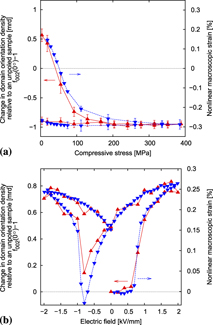Article contents
Quantitative comparison between the degree of domain orientation and nonlinear properties of a PZT ceramic during electrical and mechanical loading
Published online by Cambridge University Press: 01 April 2011
Abstract

The macroscopic electromechanical coupling properties of ferroelectric polycrystals are composed of linear and nonlinear contributions. The nonlinear contribution is typically associated with the extrinsic effects related to the creation and motion of domain walls. To quantitatively compare the macroscopic nonlinear properties of a lead zirconate titanate ceramic and the degree of domain orientation, in-situ neutron and high-energy x-ray diffraction experiments are performed and they provide the domain orientation density as a function of the external electric field and mechanical compression. Furthermore, the macroscopic strain under the application of external electrical and mechanical loads is measured and the nonlinear strain is calculated by means of the linear intrinsic piezoelectric effect and the linear intrinsic elasticity. The domain orientation density and the nonlinear strain show the same dependence on the external load. The scaling factor that relates to the two values is constant and is the same for both electrical and mechanical loadings.
- Type
- Articles
- Information
- Copyright
- Copyright © Materials Research Society 2011
References
REFERENCES
- 9
- Cited by


